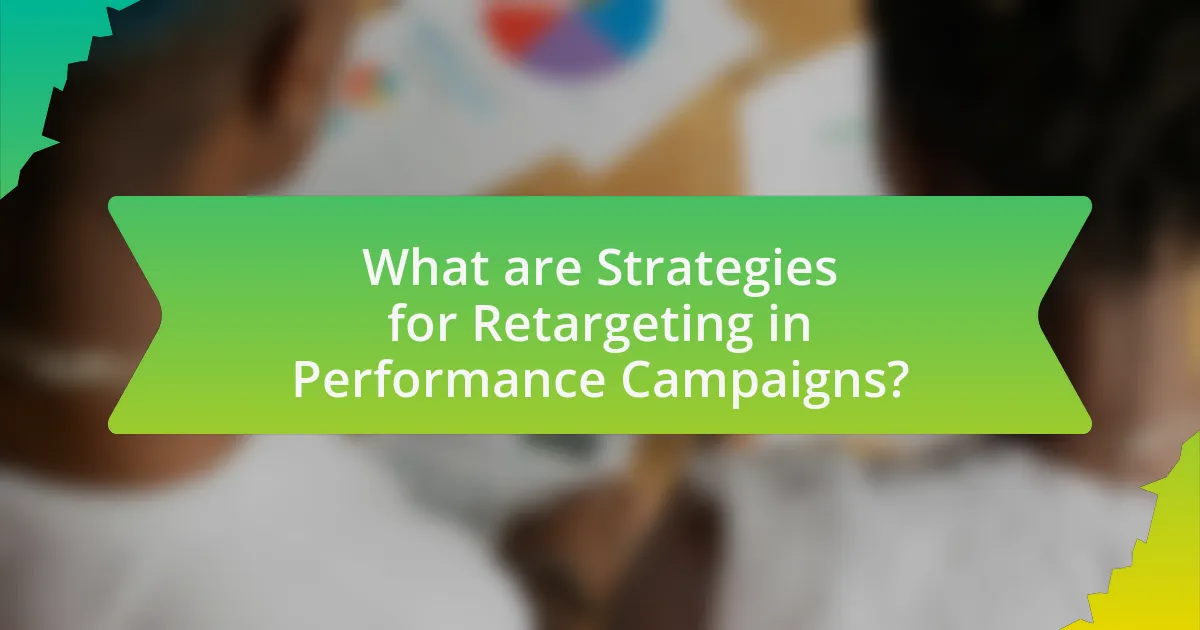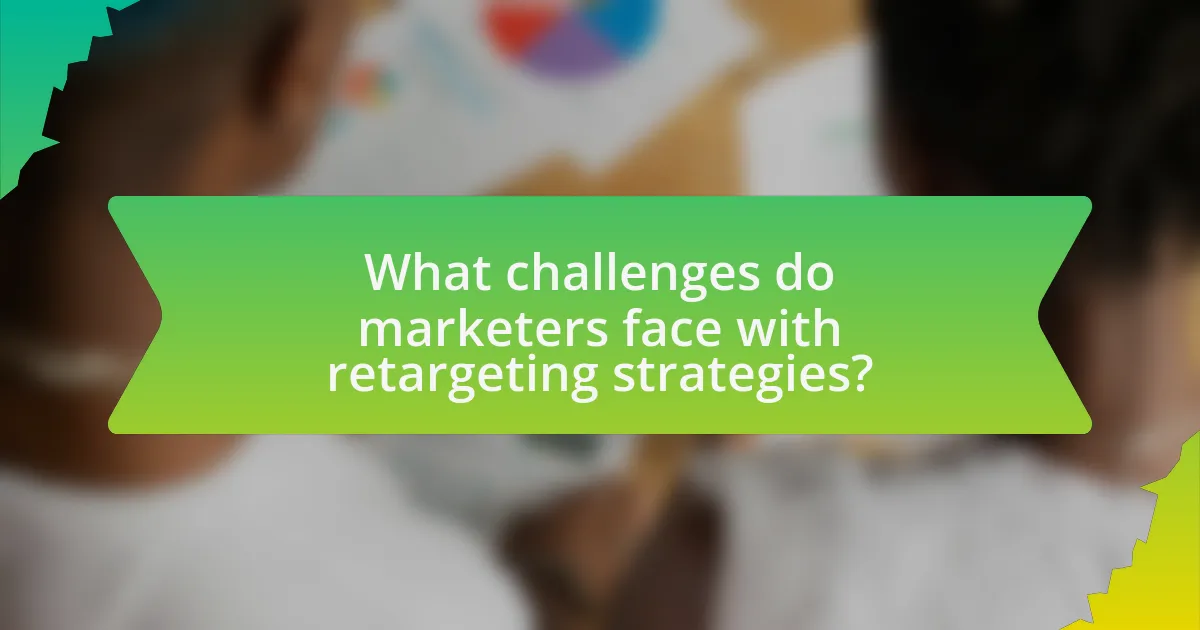The article focuses on strategies for retargeting in performance campaigns, emphasizing the importance of audience segmentation, dynamic ads, and frequency capping. It outlines how these strategies enhance user engagement and conversion rates by delivering personalized messages to users who have previously interacted with a brand. Key elements discussed include the effectiveness of retargeting in increasing click-through rates, the role of audience targeting, and the challenges marketers face, such as ad fatigue and privacy concerns. Additionally, the article highlights various retargeting methods, best practices for implementation, and the tools that can optimize campaign performance.

What are Strategies for Retargeting in Performance Campaigns?
Strategies for retargeting in performance campaigns include segmenting audiences, utilizing dynamic ads, and employing frequency capping. Segmenting audiences allows marketers to tailor messages based on user behavior, increasing relevance and engagement. Dynamic ads automatically showcase products that users have previously viewed, enhancing the likelihood of conversion. Frequency capping limits the number of times an ad is shown to the same user, preventing ad fatigue and maintaining user interest. These strategies are supported by data indicating that personalized retargeting can lead to a 10x increase in conversion rates compared to standard display ads.
How do retargeting strategies enhance performance campaigns?
Retargeting strategies enhance performance campaigns by re-engaging users who have previously interacted with a brand, thereby increasing conversion rates. These strategies utilize data-driven insights to serve targeted ads to users who have shown interest, which can lead to a higher likelihood of completing a purchase. According to a study by AdRoll, retargeting ads can lead to a 10x increase in click-through rates compared to standard display ads, demonstrating their effectiveness in driving user engagement and conversions.
What are the key elements of effective retargeting strategies?
Effective retargeting strategies primarily involve audience segmentation, personalized messaging, frequency capping, and strategic ad placement. Audience segmentation allows marketers to categorize users based on their behavior, such as pages visited or products viewed, enabling tailored messaging that resonates with specific interests. Personalized messaging enhances engagement by addressing the unique needs of each segment, increasing the likelihood of conversion. Frequency capping prevents ad fatigue by limiting the number of times an ad is shown to the same user, ensuring that the audience remains receptive. Strategic ad placement across various platforms maximizes visibility and reinforces brand recall, ultimately driving higher conversion rates. These elements collectively enhance the effectiveness of retargeting efforts in performance campaigns.
How do audience segmentation and targeting play a role in retargeting?
Audience segmentation and targeting are crucial in retargeting as they enable marketers to tailor their messages to specific groups based on their behaviors and preferences. By segmenting audiences, marketers can identify which users have interacted with their brand, such as visiting a website or abandoning a cart, and then create targeted ads that address the unique needs or interests of those segments. For instance, a study by AdRoll found that segmented retargeting campaigns can lead to a 50% increase in click-through rates compared to non-segmented approaches. This targeted strategy not only enhances engagement but also improves conversion rates, as ads resonate more with the audience’s specific context and previous interactions with the brand.
Why is retargeting important for digital marketing success?
Retargeting is important for digital marketing success because it significantly increases conversion rates by re-engaging users who have previously interacted with a brand. Studies show that retargeted ads can lead to a 10x increase in click-through rates compared to standard display ads. This effectiveness stems from the fact that retargeting keeps a brand top-of-mind for potential customers, reminding them of products or services they have shown interest in, which ultimately drives them back to the website to complete a purchase.
What statistics support the effectiveness of retargeting?
Retargeting campaigns can increase conversion rates by up to 150%. According to a study by Criteo, retargeted users are 70% more likely to convert compared to non-retargeted users. Additionally, the Digital Marketing Association reports that retargeting ads can lead to a 1046% increase in brand recall. These statistics demonstrate the significant impact of retargeting on consumer engagement and conversion metrics.
How does retargeting influence customer behavior and conversion rates?
Retargeting significantly influences customer behavior and conversion rates by reminding potential customers of products they previously viewed, thereby increasing the likelihood of purchase. Studies indicate that retargeted ads can lead to a 10-fold increase in click-through rates compared to standard display ads. This heightened engagement occurs because retargeting keeps the brand top-of-mind, encouraging users to return to the site and complete their purchases. Furthermore, according to a report by Criteo, retargeting can boost conversion rates by up to 150%, demonstrating its effectiveness in driving sales and enhancing customer retention.

What types of retargeting strategies exist?
There are several types of retargeting strategies, including standard retargeting, dynamic retargeting, and remarketing lists for search ads (RLSA). Standard retargeting displays ads to users who have previously visited a website, aiming to re-engage them. Dynamic retargeting takes this further by showing personalized ads based on the specific products or services users viewed, enhancing relevance and potential conversion rates. RLSA allows advertisers to customize search ads for users who have previously interacted with their site, targeting them with tailored messages when they search on Google. These strategies are effective in increasing brand recall and driving conversions by targeting users who have already shown interest.
How do different retargeting methods compare?
Different retargeting methods, such as site retargeting, search retargeting, and dynamic retargeting, vary in their approach and effectiveness. Site retargeting focuses on users who have previously visited a website, aiming to re-engage them through display ads, which can lead to a 10x increase in conversion rates compared to standard display ads. Search retargeting targets users based on their search queries, allowing advertisers to reach potential customers who have shown interest in specific products or services, often resulting in higher click-through rates. Dynamic retargeting personalizes ads based on user behavior and preferences, which can increase engagement by up to 50% as it showcases relevant products. Each method has its strengths, with site retargeting excelling in brand recall, search retargeting in capturing intent, and dynamic retargeting in personalization, making them suitable for different campaign objectives.
What is the difference between standard and dynamic retargeting?
Standard retargeting displays the same ad to users who have previously visited a website, while dynamic retargeting shows personalized ads based on the specific products or services that users viewed. Standard retargeting relies on a static ad creative, whereas dynamic retargeting utilizes data feeds to automatically generate ads tailored to individual user behavior, enhancing relevance and engagement. Research indicates that dynamic retargeting can lead to higher conversion rates, as it targets users with content that directly reflects their interests and previous interactions.
How can email retargeting be integrated into performance campaigns?
Email retargeting can be integrated into performance campaigns by utilizing customer data to send targeted follow-up emails based on user behavior. This approach allows marketers to re-engage users who have previously interacted with their brand but did not convert, thereby increasing the likelihood of conversion. For instance, a study by the Direct Marketing Association found that targeted emails can generate a 122% return on investment, highlighting the effectiveness of personalized communication in driving sales. By segmenting email lists based on user actions, such as abandoned carts or product views, brands can tailor their messaging to address specific interests, ultimately enhancing the performance of their campaigns.
What are the best practices for implementing retargeting strategies?
The best practices for implementing retargeting strategies include segmenting your audience, personalizing ad content, and optimizing ad frequency. Segmenting your audience allows marketers to tailor messages based on user behavior, increasing relevance and engagement. Personalizing ad content, such as showcasing products previously viewed by users, enhances the likelihood of conversion. Optimizing ad frequency prevents ad fatigue, ensuring that users are not overwhelmed by repeated exposure, which can lead to negative perceptions of the brand. According to a study by Criteo, personalized retargeting ads can lead to a 1046% increase in click-through rates, demonstrating the effectiveness of these practices.
How can marketers optimize ad frequency and timing in retargeting?
Marketers can optimize ad frequency and timing in retargeting by utilizing data-driven insights to determine the optimal number of impressions and the best times to reach their audience. By analyzing user behavior, such as the time spent on the website and the actions taken, marketers can establish a frequency cap that prevents ad fatigue while ensuring sufficient exposure. Research indicates that showing ads too frequently can lead to diminishing returns, with a study by AdRoll revealing that conversion rates drop significantly after a certain threshold of impressions. Additionally, employing A/B testing allows marketers to experiment with different timing strategies, such as targeting users during peak engagement hours, which can enhance the effectiveness of retargeting campaigns.
What role does creative content play in successful retargeting?
Creative content is essential for successful retargeting as it captures attention and engages users who have previously interacted with a brand. Engaging visuals, compelling copy, and tailored messaging can significantly increase conversion rates by reminding potential customers of their interest and encouraging them to complete their purchase. According to a study by AdRoll, retargeted ads can lead to a 10x increase in click-through rates compared to standard display ads, highlighting the effectiveness of creative content in rekindling user interest and driving action.

What challenges do marketers face with retargeting strategies?
Marketers face several challenges with retargeting strategies, primarily including ad fatigue, privacy concerns, and targeting accuracy. Ad fatigue occurs when users see the same ads repeatedly, leading to decreased engagement and effectiveness. Privacy concerns have intensified due to regulations like GDPR and CCPA, which restrict how marketers can collect and use consumer data for retargeting. Additionally, targeting accuracy can be compromised by cookie restrictions and the decline of third-party cookies, making it difficult for marketers to effectively reach their intended audience. These challenges necessitate continuous adaptation and optimization of retargeting strategies to maintain effectiveness in performance campaigns.
How can privacy concerns impact retargeting efforts?
Privacy concerns can significantly hinder retargeting efforts by limiting the data available for targeting and reducing user engagement. As regulations like the General Data Protection Regulation (GDPR) and the California Consumer Privacy Act (CCPA) impose strict guidelines on data collection and usage, advertisers face challenges in obtaining consent for tracking user behavior. For instance, a survey by the Interactive Advertising Bureau (IAB) found that 70% of consumers are concerned about how their data is used, leading to increased opt-out rates from tracking mechanisms. This results in less effective retargeting campaigns, as advertisers struggle to reach users who have shown interest in their products or services. Consequently, privacy concerns can lead to reduced ad personalization, lower conversion rates, and ultimately, diminished return on investment for performance campaigns.
What regulations should marketers be aware of when retargeting?
Marketers should be aware of regulations such as the General Data Protection Regulation (GDPR) and the California Consumer Privacy Act (CCPA) when retargeting. GDPR mandates that marketers obtain explicit consent from users before collecting and processing their personal data, while CCPA provides California residents with rights regarding their personal information, including the right to opt-out of data selling. Non-compliance with these regulations can result in significant fines; for instance, GDPR violations can incur penalties of up to €20 million or 4% of annual global turnover, whichever is higher. Therefore, understanding and adhering to these regulations is crucial for marketers engaged in retargeting efforts.
How can marketers address user fatigue with retargeting ads?
Marketers can address user fatigue with retargeting ads by implementing frequency capping, which limits the number of times an individual sees the same ad. This strategy helps prevent overwhelming users with repetitive messages, thereby reducing annoyance and increasing engagement. Research indicates that ads shown more than three times can lead to diminishing returns, as users may develop negative perceptions of the brand. Additionally, marketers can diversify ad creatives and messaging to keep the content fresh and relevant, which has been shown to improve user response rates. By analyzing user behavior and segmenting audiences, marketers can tailor retargeting efforts to specific interests, enhancing the likelihood of positive interactions.
What tools and technologies can enhance retargeting strategies?
Tools and technologies that can enhance retargeting strategies include programmatic advertising platforms, customer relationship management (CRM) systems, and data management platforms (DMPs). Programmatic advertising platforms, such as Google Ads and Facebook Ads, enable advertisers to automate the buying of ad space and target specific audiences based on their online behavior. CRM systems, like Salesforce, allow businesses to track customer interactions and tailor retargeting efforts based on user data. DMPs, such as Adobe Audience Manager, aggregate and analyze data from various sources, helping marketers create more effective audience segments for retargeting campaigns. These tools collectively improve the precision and effectiveness of retargeting efforts, leading to higher conversion rates.
Which platforms offer robust retargeting capabilities?
Google Ads, Facebook Ads, and AdRoll offer robust retargeting capabilities. Google Ads allows advertisers to create custom audiences based on user behavior across the Google Display Network, enabling targeted ads to users who have previously interacted with their website. Facebook Ads provides dynamic retargeting options through its pixel, allowing businesses to show personalized ads to users based on their previous actions on the site. AdRoll specializes in retargeting across multiple platforms, leveraging data to optimize ad placements and reach users effectively. These platforms are widely recognized for their advanced targeting features and extensive reach, making them essential tools for effective retargeting strategies in performance campaigns.
How can analytics improve retargeting campaign performance?
Analytics can significantly improve retargeting campaign performance by providing insights into user behavior and preferences. By analyzing data such as website interactions, conversion rates, and customer demographics, marketers can tailor their retargeting efforts to target specific segments more effectively. For instance, a study by AdRoll found that personalized retargeting ads can lead to a 10 times higher click-through rate compared to generic ads. This data-driven approach allows for the optimization of ad placements, messaging, and timing, ultimately enhancing engagement and conversion rates in retargeting campaigns.
What are some practical tips for successful retargeting in performance campaigns?
Successful retargeting in performance campaigns requires a strategic approach that includes segmenting audiences, personalizing ads, and optimizing ad frequency. Segmenting audiences allows marketers to tailor messages based on user behavior, increasing relevance and engagement. Personalizing ads with dynamic content can significantly improve click-through rates; for instance, personalized ads can lead to a 10% increase in conversion rates, as shown by a study from Epsilon. Optimizing ad frequency ensures that users are not overwhelmed, maintaining a balance that keeps the brand top-of-mind without causing ad fatigue. Implementing these strategies can enhance the effectiveness of retargeting efforts in performance campaigns.


